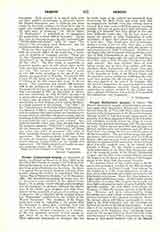

Priests’ Eucharistic League. —I. Object.—The Priests’ Eucharistic League (Confraternitas sacerdotalis adorationis Sanctissimi Sacramenti) was established in Paris by the Venerable Pierre-Julien Eymard, founder of the Congregation of the Blessed Sacrament. Already in 1857 he had been deeply impressed by the necessity of such an adaptation of his work of Eucharistic adoration as would attract the clergy to a more intimate and constant intercourse with the sacramental Lord. Still it was not until 1867 that the plan of a distinct confraternity was matured, and the Blessed Cure d’Ars was among the first to enrol his name on the list of members. The association assumed its presentform in 1879, received the approval of Leo XIII on January 25, 1881, and six years later, on January 16, 1887, was definitively approved and canonically erected by Cardinal Parocchi, cardinal vicar, in the church of S. Claudio in Rome. To this church is attached the Archconfraternity of the Most Holy Sacrament, and it is the canonical center of the Priests’ Eucharistic League; but the office of the central administration of the league is at the house of the fathers of the Congregation of the Most Holy Sacrament, Brussels.
The primary object of this confraternity is the frequent and prolonged worship of the Blessed Sacrament by priests. As Christ is truly “God with us” in the Eucharist, it is His desire that priests should appear often in His presence and remain for reverent and affectionate intercourse. From this close intimacy a higher spiritual life must ensue. At this source priests will learn how to adore Him in spirit and in truth and draw light and power to carry out more fruitfully their apostolic mission. Its next object is to extend the Kingdom of Christ by forming apostles of the Eucharist. Reverent and docile companionship brings knowledge, love, and a desire to share with others the precious treasures of this supreme sacrament. Hence the devout adorer will labor assiduously to revive faith in the Holy Eucharist, and will encourage the faithful to partake of the life-giving banquet. A third object of the confraternity is to band together priests as apostles of the Eucharist who “will pledge themselves to take up and defend on all occasions the cause and the honor of Jesus Christ, and promote by every means in their power frequent visits to the Blessed Sacrament as well as frequent communion”. The regular and associated practice of the weekly adoration fosters a spirit of religious brotherhood. Priests animated by the Eucharistic spirit, impelled by the Eucharistic instinct, will be stimulated by the example of the neighboring clergy and by a sense of spiritual companionship with a vast unseen array of associates performing the same acts of homage and devotion in all parts of the world.
The precise and specific works of the association are the following: (I) to spend each week one full and continuous hour of adoration before the Blessed Sacrament exposed on the altar or veiled in the tabernacle; (2) to report monthly to the local director on a prescribed schedule (libellus) the performance of the above undertaking; (3) to apply once a month the indulgences attached to the hour of adoration for the benefit of the souls of members who may have died during the previous month; (4) to offer the Holy Sacrifice once a year for all deceased members of the association. Repeated failure to transmit the libellus entails, after due warning, loss of membership.
II. Membership and Privileges.—The confraternity was originally intended for members of the secular clergy only; but as far back as 1898 the admission of religious has been authorized; and by a concession of the superior general of the Congregation of the Blessed Sacrament dated November 2, 1902, seminarists in the United States become eligible for admission even before receiving the subdiaconate. The Holy See has favored the practice of this devotion with numerous advantages, notably with the singularly rich indulgences of “The Station of the Blessed Sacrament” (Beringer, “Les Indulgences“, II, 129), and the faculty of granting the indulgence of the Crosier Fathers (cf. Beringer, I, 504).
III. Organization.—The organization of the confraternity enjoys the merit of simplicity. Ordinary members are grouped under their respective diocesan directors. These are united under a general director for a district or a whole country, while the entire association throughout the world is subject to the central direction of the Fathers of the Blessed Sacrament at Brussels. For the greater convenience of administration local centers have been established in Austria, Argentina, Canada, Chili, Holland, Italy, Spain, and the United States. The diocesan directors are elected by members with the approval of the ordinary. They officially represent the confraternity in a diocese and maintain its efficiency and regular working. The life and energy of the members is promoted by periodical assemblies of the respective groups. Conferences of diocesan members are held on the occasion of the clergy retreats and at other convenient times. In the United States, besides these diocesan conferences, conventions of several dioceses have been held at Covington, Kentucky (1894), at Notre Dame, Indiana (1894, 1898), and at Philadelphia (1899). More important gatherings from a large number of dioceses, called congresses, have been held at Washington (1893), St. Louis (1901), New York (1904), and Pittsburg (1906). The numerous local congresses held in France form a significant feature of the religious activity of the Church there (cf. “Annales”, 1909, pp. 446-9; 1910, p. 158). Perhaps the most noteworthy characteristic of the confraternity is the rapidity with which it has spread throughout every portion of the world. Canada has a total of two thousand four hundred and fifty members, the United States 8015, while the grand total for the whole confraternity in March of the year 1911 is one hundred thousand five hundred and sixty-one, of whom twelve are cardinals and two hundred and forty bishops or archbishops. The real value of these figures is checked by the record kept of the individual reports sent in by members of their discharge of the duty of the weekly hour of adoration. Should a member have failed for a year to send in his libellus, he receives a reminder, which, if ineffective, is followed by the removal of his name from the register.
IV. Literature.—A number of monthly periodicals serve to maintain the fervor and activity of the associates: the “Emmanuel” (sixteenth year; New York); “Annales des Pretres Adorateurs” (twenty-third year; Brussels); “Annales de I’Association des Pretres Adorateurs” (twenty-third year; Brussels); “Annali dei Sacerdoti Adoratori” (sixteenth year; Turin); “Anales de los Sacerdotes Adoradores” (third year; Buenos Aires); “SS. Eucharistia” (twentieth year; Bozen), the organ of the league for Austria, Germany, and Switzerland; “Eucharist and Priest” (sixteenth year; Verapoly, Malabar Coast). In addition to these sources of information and piety, there is much dogmatic and devotional literature on the subject of the hour of adoration, such as “The Real Presence”, “The Month of our Lady of the Blessed Sacrament”, “The Month of Mary”, “The Month of St. Joseph“, by the Venerable Pere Eymard. The late Pere Tesniere published: “The Adoration of the Blessed Sacrament”; “The Eucharistic Christ”; “The Eucharistic Heart”; “The Mysteries of the Rosary“. The commendable practice has much increased among the members of the confraternity of making the hour of adoration at a time when the faithful are able to take part in it. Private or solemn exposition is adopted according to circumstances, and for the benefit of the faithful prayers are recited and suitable hymns sung between the intervals of meditation. In this connection the associations, entitled “Agregation du tres saint Sacrement” and “Oeuvre de l’Exposition Menseulle du tres saint Sacrement clans les Paroisses”, will be of service.
HENRY PARKINSON


